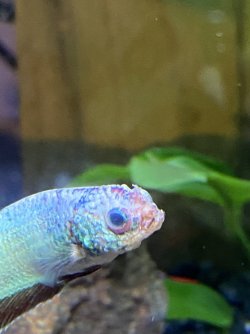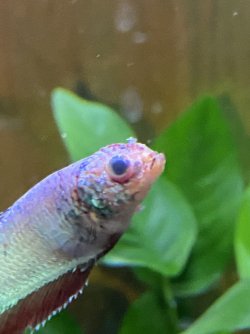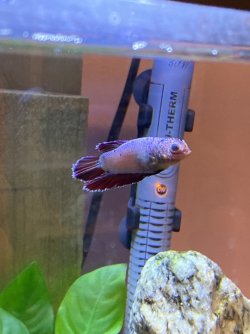You are using an out of date browser. It may not display this or other websites correctly.
You should upgrade or use an alternative browser.
You should upgrade or use an alternative browser.
Unknown affliction
- Thread starter CMBrown69
- Start date
-
- Tags
- help advice needed
what are the params?
can you use the template on the Emergency section?
can you use the template on the Emergency section?
Hi and welcome to the forum 
Can you post more pictures of the fish. Show the entire fish from both sides.
What is the ammonia, nitrite, nitrate and pH of the tank water?
How long has the tank been set up for?
What sort of fish is it? It looks a bit like a Betta?
How long have you had the fish?
What other fish are in the tank?
How long has the fish been like that?
Have you added anything to the tank in the 2 weeks before this started?
Was the other fish that died the same type of fish and did you get it from the same place?
Tell us about that fish and its history, including anything you tried to treat it with.
Did you clean the tank after that fish died?
--------------------
It looks like a bad bacterial infection on a Betta splendens (Siamese fighting fish). It will probably need a broad spectrum medication that treats fungus and bacteria. However, without knowing more details that is all I can suggest.
--------------------
Before you treat the tank, do the following things.
Work out the volume of water in the tank:
measure length x width x height in cm.
divide by 1000.
= volume in litres.
If you have big rocks or driftwood in the tank, remove these before measuring the height of the water level so you get a more accurate water volume.
When you measure the height, measure from the top of the substrate to the top of the water level.
You can use a permanent marker to draw a line on the tank at the water level and put down how many litres are in the tank at that level.
There is a calculator/ converter in the "FishForum.net Calculator" under "Useful Links" at the bottom of this page that will let you convert litres to gallons if you need it.
Remove carbon from the filter before treating or it will adsorb the medication and stop it working.
Wipe the inside of the glass down with a clean fish sponge. This removes the biofilm on the glass and the biofilm will contain lots of harmful bacteria, fungus, protozoans and various other microscopic life forms.
Do a 75% water change and gravel clean the substrate. The water change and gravel cleaning will reduce the number of disease organisms in the water and provide a cleaner environment for the fish to recover in. It also removes a lot of the gunk and this means any medication can work on treating the fish instead of being wasted killing the pathogens in the gunk.
Make sure any new water is free of chlorine/ chloramine before it is added to the tank.
Clean the filter if it hasn't been done in the last 2 weeks. However, if the filter is less than 6 weeks old, do not clean it. Wash the filter materials/ media in a bucket of tank water and re-use them. Tip the bucket of dirty water on the garden/ lawn. Cleaning the filter means less gunk and cleaner water with fewer pathogens.
Increase surface turbulence/ aeration when using salt or medications because they reduce the dissolved oxygen in the water.
Can you post more pictures of the fish. Show the entire fish from both sides.
What is the ammonia, nitrite, nitrate and pH of the tank water?
How long has the tank been set up for?
What sort of fish is it? It looks a bit like a Betta?
How long have you had the fish?
What other fish are in the tank?
How long has the fish been like that?
Have you added anything to the tank in the 2 weeks before this started?
Was the other fish that died the same type of fish and did you get it from the same place?
Tell us about that fish and its history, including anything you tried to treat it with.
Did you clean the tank after that fish died?
--------------------
It looks like a bad bacterial infection on a Betta splendens (Siamese fighting fish). It will probably need a broad spectrum medication that treats fungus and bacteria. However, without knowing more details that is all I can suggest.
--------------------
Before you treat the tank, do the following things.
Work out the volume of water in the tank:
measure length x width x height in cm.
divide by 1000.
= volume in litres.
If you have big rocks or driftwood in the tank, remove these before measuring the height of the water level so you get a more accurate water volume.
When you measure the height, measure from the top of the substrate to the top of the water level.
You can use a permanent marker to draw a line on the tank at the water level and put down how many litres are in the tank at that level.
There is a calculator/ converter in the "FishForum.net Calculator" under "Useful Links" at the bottom of this page that will let you convert litres to gallons if you need it.
Remove carbon from the filter before treating or it will adsorb the medication and stop it working.
Wipe the inside of the glass down with a clean fish sponge. This removes the biofilm on the glass and the biofilm will contain lots of harmful bacteria, fungus, protozoans and various other microscopic life forms.
Do a 75% water change and gravel clean the substrate. The water change and gravel cleaning will reduce the number of disease organisms in the water and provide a cleaner environment for the fish to recover in. It also removes a lot of the gunk and this means any medication can work on treating the fish instead of being wasted killing the pathogens in the gunk.
Make sure any new water is free of chlorine/ chloramine before it is added to the tank.
Clean the filter if it hasn't been done in the last 2 weeks. However, if the filter is less than 6 weeks old, do not clean it. Wash the filter materials/ media in a bucket of tank water and re-use them. Tip the bucket of dirty water on the garden/ lawn. Cleaning the filter means less gunk and cleaner water with fewer pathogens.
Increase surface turbulence/ aeration when using salt or medications because they reduce the dissolved oxygen in the water.
The water quality to good, only bad thing is the hardness which I’m trying to correct.Hi and welcome to the forum
Can you post more pictures of the fish. Show the entire fish from both sides.
What is the ammonia, nitrite, nitrate and pH of the tank water?
How long has the tank been set up for?
What sort of fish is it? It looks a bit like a Betta?
How long have you had the fish?
What other fish are in the tank?
How long has the fish been like that?
Have you added anything to the tank in the 2 weeks before this started?
Was the other fish that died the same type of fish and did you get it from the same place?
Tell us about that fish and its history, including anything you tried to treat it with.
Did you clean the tank after that fish died?
--------------------
It looks like a bad bacterial infection on a Betta splendens (Siamese fighting fish). It will probably need a broad spectrum medication that treats fungus and bacteria. However, without knowing more details that is all I can suggest.
--------------------
Before you treat the tank, do the following things.
Work out the volume of water in the tank:
measure length x width x height in cm.
divide by 1000.
= volume in litres.
If you have big rocks or driftwood in the tank, remove these before measuring the height of the water level so you get a more accurate water volume.
When you measure the height, measure from the top of the substrate to the top of the water level.
You can use a permanent marker to draw a line on the tank at the water level and put down how many litres are in the tank at that level.
There is a calculator/ converter in the "FishForum.net Calculator" under "Useful Links" at the bottom of this page that will let you convert litres to gallons if you need it.
Remove carbon from the filter before treating or it will adsorb the medication and stop it working.
Wipe the inside of the glass down with a clean fish sponge. This removes the biofilm on the glass and the biofilm will contain lots of harmful bacteria, fungus, protozoans and various other microscopic life forms.
Do a 75% water change and gravel clean the substrate. The water change and gravel cleaning will reduce the number of disease organisms in the water and provide a cleaner environment for the fish to recover in. It also removes a lot of the gunk and this means any medication can work on treating the fish instead of being wasted killing the pathogens in the gunk.
Make sure any new water is free of chlorine/ chloramine before it is added to the tank.
Clean the filter if it hasn't been done in the last 2 weeks. However, if the filter is less than 6 weeks old, do not clean it. Wash the filter materials/ media in a bucket of tank water and re-use them. Tip the bucket of dirty water on the garden/ lawn. Cleaning the filter means less gunk and cleaner water with fewer pathogens.
Increase surface turbulence/ aeration when using salt or medications because they reduce the dissolved oxygen in the water.
The other was also a betta with an enlarged belly that made her scales stick straight out.
The only thing I’ve added is another betta to replace the one that died.
Attachments
That is a really bad bacterial infection.
A broad spectrum medication might help but it might need anti-biotics, assuming it isn't too far gone.
If the other Betta bloated up and the scales stuck out from the body, it had dropsy and that is usually caused by an internal problem, and regularly by an internal bacterial infection.
-------------------
If you use anti-biotics, use them in a bare tank without rocks, gravel or filter. You can have a few plants for the fish to feel safe but not much else.
Treat the tank as per the directions.
Before you re-treat the tank, wipe it out and change all the water. Refill it with clean dechlorinated water and add the next dose of anti-biotics.
Continue treatment until the fish has healed.
If there is no improvement after 2 days with anti-biotics, they probably aren't going to work.
I can't offer much advice on which anti-biotic to use because they are limited where I am. But Furan 2 or Kanaplex might help. Some people use both at the same time but I don't recommend mixing chemicals or anti-biotics.
A broad spectrum medication might help but it might need anti-biotics, assuming it isn't too far gone.
If the other Betta bloated up and the scales stuck out from the body, it had dropsy and that is usually caused by an internal problem, and regularly by an internal bacterial infection.
-------------------
If you use anti-biotics, use them in a bare tank without rocks, gravel or filter. You can have a few plants for the fish to feel safe but not much else.
Treat the tank as per the directions.
Before you re-treat the tank, wipe it out and change all the water. Refill it with clean dechlorinated water and add the next dose of anti-biotics.
Continue treatment until the fish has healed.
If there is no improvement after 2 days with anti-biotics, they probably aren't going to work.
I can't offer much advice on which anti-biotic to use because they are limited where I am. But Furan 2 or Kanaplex might help. Some people use both at the same time but I don't recommend mixing chemicals or anti-biotics.
Similar threads
- Replies
- 10
- Views
- 503




